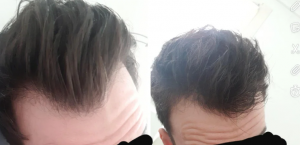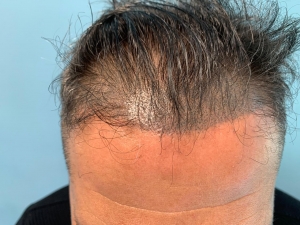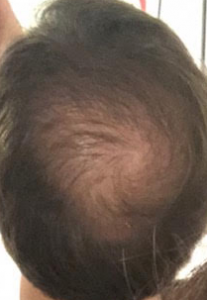Here is a man who also had 3200 grafts I just posted last week when he sent me these photos: https://baldingblog.com/hair-growth-gone-wild-photos/ and you can see what I mean by amazing.
This man had 2900 grafts by us and these results are shown below. He said he was ‘carded’ recently and that was by itself, one of those very satisfying moments when he had to show his driver’s license displaying his age of 32. The crown was treated lightly as there were not enough grafts to cover it more thickly so it will be followed up with Scalp Micropigmentation.
Is there any hard in bleaching my hair 5 months after a hair transplant? Does bleaching your hair actually damage the follicle or just the hair (which I can cut off anyways because my hair is short). Any insight on whether I could or could not do this would be great! I’m mainly concerned whether or not the bleach would damage the new grafts.
Dying your hair after a hair transplant will not harm the hair, provided that is is done professionally. The bleach you use should not stay on your scalp too long or it will kill your hair.
Should you be shedding in areas of your head where you weren’t shedding before?
You must keep in mind that genetic balding is the enemy, which is a progressive process in ALL men– so when you see new shedding, think progression, not finasteride as the cause.
So I have no receding in the front or temples, basically it’s NW1, but the crown is somewhat thinner I think and having some hair fall Went to the dermatologist and she said there’s no indication of MBP, but I can feel my density has decreased from the year before
Hair loss often starts in the crown in some people. Also in young men, the hairline evolves from its rounded, juvenile concave shape to a V-Shaped convex shape called the mature hairline. If there is thinning in the crown (which I would confirm with the HAIR CHECK test ( https://baldingblog.com/haircheck-test-how-it-is-done-and-what-its-value/ ), then I would start the person on finasteride and minoxidil applications, which in combination work well to stop or probably reverse the crown loss. To see the effectiveness of this treatment, I repeat the HAIR CHECK test yearly.
I read a few articles online and found out you cannot donate blood due to taking fin. This really upsets me because have a rare blood type and I feel great when donating my blood. Unfortunately, I’m going to choose my hair over donation
You can’t donate blood while you are on finasteride because if a pregnant woman got it, it would impact her baby.
I am not sure why this worked, but it did.
This is a complication of a hair transplant, about as bad as one can get. This is massive folliculitis with pus draining from many of the pus pockets on his head (look carefully and you can see this). One might ask why this happened and I would make the following comments:
- In over 16,000 hair transplant procedure in the 8 different offices I have operated, I have never seen anything like this in my practice.
- This is most likely the result of a breakdown of the clean/sterile environment required for any surgical procedure, including the use of sterilized equipment, surgical tools and sterile disposable gauze, gloves and the like.
- This patient should have sought medical attention way before these pustules advanced to such a level.
- Each and every one of these pustules requires drainage by a surgeon and a culture and sensitivity for the bacteria that has caused this. This is critical for a successful rapid recovery because sometimes the antibiotic is not the correct antibiotic to kill the identified bacteria. The lab which tests for antibiotic sensitivities will tell which antibiotic will work to kill these bacteria. Infections with staphylococcus are often resistant to many antibiotics, so such tests are critically important when treating such a condition.
- His chance of losing the hair grafts that were transplanted is high
This picture recovered from a medical forum
Page 5 of 8











